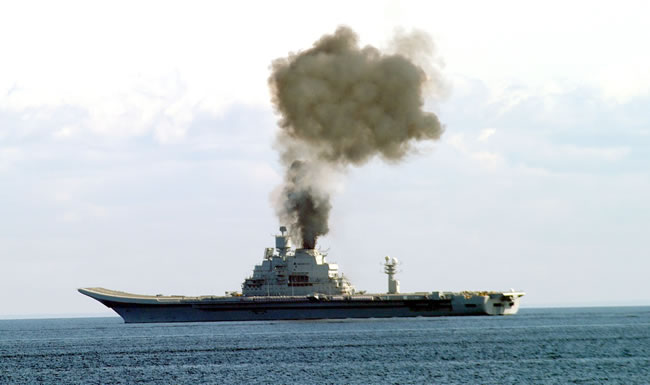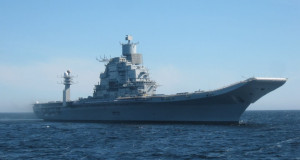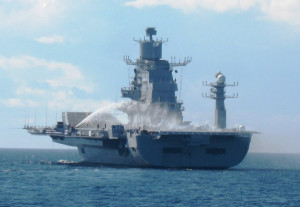

Major issues reported during the recent sea trials at the Barnets Sea are delaying the completion and handover of the refurbished Russian built Admiral Gorshkov, aircraft carrier to the Indian Navy at least until July 2013. The handover of INS Vikramaditya was scheduled for December 4, 2012 but due to the mandatory repairs that follow the sea trials, the vessel will be delivered not earlier than fall 2013. Overall, the Indian Navy confirmed the vessel performed well in the tests, and approved the necessary corrections, that would prolong the carrier’s refurbishment through at least four months. However, Indian officials said delaying the delivery of the vessel until autumn is unacceptable. India has called for the Russians to step up the workforce at the Sevmash shipyard for the refit-repair of Vikramaditya. “A leeway of three to four months is provided in the contract after the December delivery date… Beyond that, penalty clauses and liquidity damages could kick in,” said an Indian government source. The two sides agreed the refit-repair job would be completed within 67 months.

Among the issues uncovered were faulty boilers, which failed to perform properly. Part of the issue was the boiler insulation. According to the Russian sources, the Chinese-made insulation bricks did not meet the necessary standard, causing the boilers to dissipate heat, therefore failing to reach the maximum speed of 29 knots. Chinese officials deny China has exported such products to Russia. The Russian designers suggested to use asbestos for insulation but the Indians opted not to use this material, known to be a health hazards. The replacement of the tiles is expected to take four months, but will not necessitate dismemberment of the structure. It will be performed while the ship is afloat, moored at the shipyard. Vikramaditya is slated to be loaded on the dry dock again for two month for further inspections and will be ready for renewed sea trials by July 2013.[ismember]Read more on the planned repair at Russia & India Report[ismember]
[nonmember]Get the full details in our premium version, reserved forsubscribers.[/nonmember]
[ismember]While the refurbished ship maintains almost the same displacement, it is longer and wider than the Kiev Class:
The eight boilers used in the Kiev Class vessel were converted under the refurbishment to burn diesel fuel rather than fuel oil used in the original version. These boilers are running four-shaft geared steam turbines of 180,000 SHP. The ship also operates six Wärtsilä 1.5mW diesel generators.
Another major change from the Kiev design was the replacement of the bow’s missile deck with the ‘ski-jump deck. Kiev originally developed as an air-defense vessel supporting strategic submarines and other surface vessels, employed a 2/3 length angled flight deck, supporting Yak-38 Short Take-Off and Vertical Landing (STOVL) fighters. It also mounted a complement of surface attack and air-defense missiles. Operating as the hub for a sea-based strike force, Vikramaditya employs Short Take Off but Arrested Recovery (STOBAR) concept of operation, launching fixed wing aircraft over the bow’s 14.3-degree ski-jump. The carrier will recover the MiGs over the angled deck, fitted with three arrestor wires on the stern of the angled deck. This configuration will enable the operation of both Sea Harrier and new MiG-29Ks. The Russian navy operating the Su-33 on the Kuznetsov uses four arrestor cables to handle the heavier fighter. The MiGs will be able to take off from the ship after 160-180 mw run with full afterburner power.
The carrier will operate an air wing comprising 30-34 MiG-29Ks, along with several Kamov helicopters – K-28 anti-submarine warfare, Ka-29 search and rescue and Ka-31 radar picket helicopters. The vessel currently has no defensive weapons, however, 2-4 Kashtan close-in air defense air-defense systems are likely to be installed a before the vessel is delivered.
Through the refurbishment the original vessel’s radars were replaced with two new radars. The E-Band Fregat M2EM 3D on the highest point of the island, above the cylindrical radom, is an air surveillance / surface search radar covering 360 degrees at ranges out to 250 km. Mounted at the fore panel of the island, below the cylinder, is the C-band Podberezovik-ET1 air surveillance radar. This sensor can detect targets at twice the range (up to 500 km). Dual, redundant landing systems are also installed, the Resistor automatic landing system and the Luna optical landing system placed in white radomes in the stern, superstructure (cylindrical ring below the Fregat radar) and on the mast astern of the island.
The Russian company Salut provided both radars. Other equipment includes a Global marine communications suite, Sperry Bridgemaster navigation radar, an IFF Mk XI system and modern datalinks. A crew of 1,924 officers and seamen, of which 763 will be part of the air-wing component, will operate the Vikramaditya.
[/ismember]
Originally built by the Ukraine Nikolayev shipyard, ‘Admiral Gorshkov’, one of four Project 1143.4 ‘Kiev’ class flat-deck aircraft built in the 1980s. Admiral Gorshkov was commissioned in 1987 and was operated with the Russian Navy for nine years. Three of the four vessels of this class were scrapped in 1993 – two were sold to China for use as a military theme park and museum. China has also acquired another refurbished aircraft carrier from Russia – the Varyag, recently renamed Liaoning. Varyag was one of two ‘Admiral Kuznetzov’ class carriers built by the Ukraine Nikolayev shipyard. The second, Admiral Kuznetsov, is the only aircraft carrier currently operated by the Russian Navy.
India and Russia have reached an agreement on the refurbishment and transfer of the carrier in 2005, as part of a 947 million contract. However, following a series of delays and complications uncovered through the refurbishment process that cost has more than doubled, to $2.3 billion.
This article is part of three-part series including:
- Toward a ‘New Age of Carriers’ in Asia Pacific
- Vikramaditya Delivery Delayed to October 2013
- Liaoning Commissioned into Chinese Navy Service


















